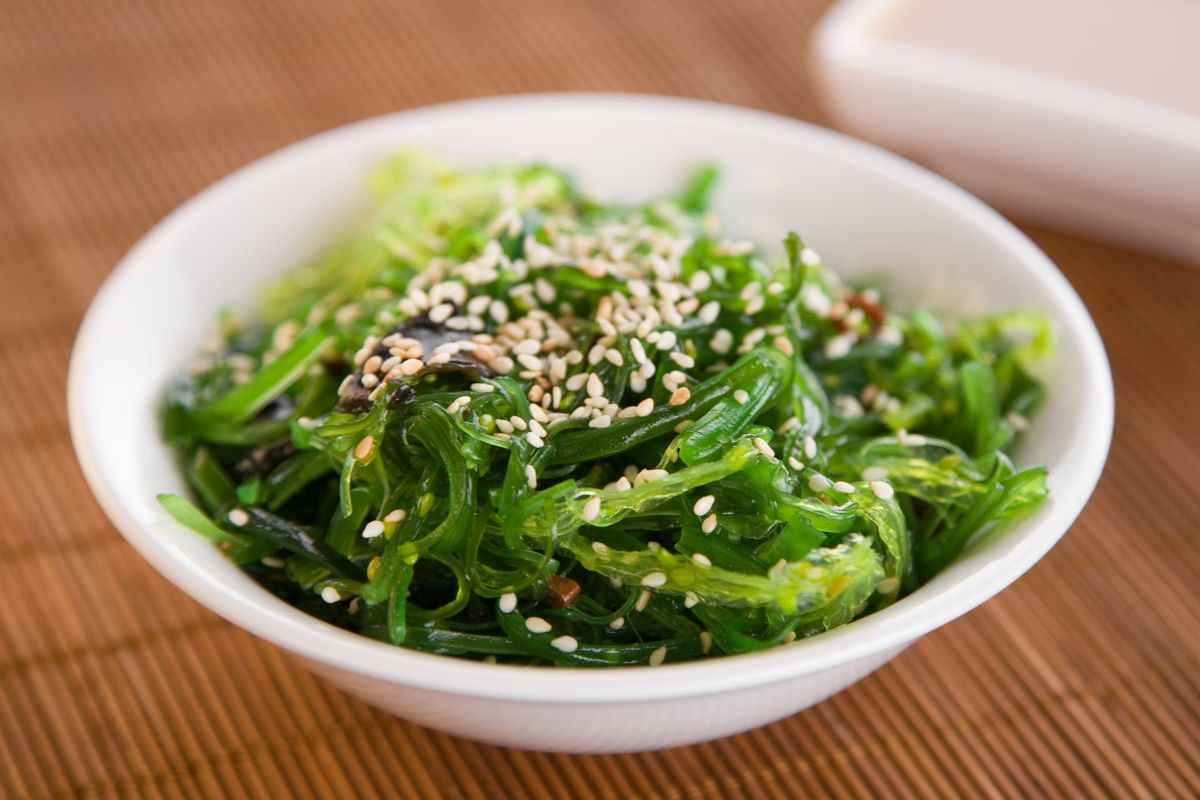Seaweed is often underestimated, but it can add interesting flavors to a lot of different dishes, particularly when using its fresh form. Despite its usefulness, many people don’t want to try it, believing that it tastes similar to seafood found in the ocean.

This may make you wonder, what does seaweed taste like? Well, it isn’t gooey, slimy, or fishy, as a lot of people may initially believe!
Essentially, fresh seaweed has strong salty, umami flavors, along with a slight spiciness. We’ll cover more about seaweed’s flavors in this post, including different forms of seaweed and how cooking can change its taste.
Keep reading to discover how seaweed tastes!
More About Seaweed
Though seaweed is useful, a lot of people have misunderstandings about what it is.
You may initially think that seaweed is the slimy, green strands of algae that entwine your legs when you swim in the ocean. This isn’t an entire misconception, but seaweed involves more than this.
The name seaweed covers loads of various types of marine plants. These all come in different sizes, from lengthy to very small. Seaweed comes in several consistencies and shapes that give each variety different looks.
As they are like the ocean version of leafy greens found on land, each type has its own different taste profile.
Seaweed was traditionally used in East Asian cuisine, but additional coastal areas began to use it in their dishes after finding out it was edible.
These countries include Scotland, Scandinavia, Chile, Hawaii, South Africa, and Ireland.
Different Seaweed Varieties
Seaweed mainly comes in two different forms. Nori, known as dried seaweed, is the most common. Nori is available in rectangular sheets or ribbon rolls, which are often used in sushi making.
Nori has, to a certain degree, been recognized in the majority of cuisines. It has a balanced taste which has no fishy flavor. As it is wafer-thin, it has a pleasant, crisp consistency.
Dried seaweed is different from fresh seaweed, which is less common. Many people are unfamiliar with this type as it is hard to access. You can only find fresh seaweed in specialty shops, in coastal towns that need the ingredient for their dishes, or if you know a connection to someone.
As fresh seaweed is an unknown ingredient to most countries around the globe, it comes with some large misunderstandings about its smell and taste. We’ll cover these more in the following sections.
Does Seaweed Smell Strange?
Fresh seaweed can have a potent ocean smell which may be pleasant at first, but can rapidly turn bad. Its distinct saltiness may change to a putrid odor in just a few hours.
Fresh seaweed should only smell like clean ocean water. If it smells bad, the seaweed may have started rotting, and won’t be best for consumption.
Some suppliers may use a mixture of vinegar, gum, and rice flour to remove fishy smells from seaweed. If this is the case, look out for signs that the seaweed has spoiled.
Your seaweed should always have a strong green pigment. Leaves that look like they have lost color, or ones with white tips, are unsuitable for consumption.
How Does Seaweed Taste?
Several people are wary about trying fresh seaweed, but if you give it a go, you might be surprised!
As there are so many types of seaweed, they will all have different tastes. Your flavor preferences will dictate which types you like the best.
It’s like preferring vanilla ice cream over chocolate – they have similar textures and an overall sweet flavor, but you may like certain notes within vanilla better.
Just like all types of ice cream taste sweet, every type of seaweed has a distinct, salty taste. This is because all seaweed is sourced from the ocean’s salty waters, giving the ingredient its briny qualities.
There are also noticeable mineral notes within each kind of seaweed, which is usually the strongest flavor note you’ll notice.
The majority of seaweed varieties also take on umami characteristics. If you haven’t heard the term umami before, it refers to slightly meaty flavors.
It’s similar to broths, fermented ingredients, cooked steaks, and mushrooms. Umami is one of the five types of flavors, which also include salty, sweet, bitter, and sour.
While most kinds of seaweed have these salty, mineral, and umami flavors, there are a few types that have a slight spiciness to them. This isn’t as spicy as wasabi or chili, but more similar to the sharp notes in onion or garlic.
These ingredients aren’t necessarily spicy, but they deliver a slight tingling feeling in the mouth. Several kinds of seaweed also do this, like Atlantic Dulse.
As seaweed is a kind of ocean plant, it also has a herby taste to it. It’s like boiled spinach which has been treated with lots of salt. This has a fresh, green, earthy taste with powerful salty overtones.
Will Seaweed Taste Like Fish?
A lot of people that don’t want to try seaweed are scared that it will taste like fish.
Naturally, as seaweed is sourced from the sea, it will take on ocean qualities. However, while it may have a slight oceanic flavor, it won’t taste like fish, or seafood itself.
Seaweed isn’t fish, but instead a plant that grows in the sea. It does have umami characteristics, but this is a far cry from the meaty flavors coming from fish.
Overall, seaweed will have a fresh, salty flavor that resembles the ocean, but it won’t have an overwhelming fishy taste.
Can Cooking Change The Way Seaweed Tastes?

Cooking can also affect the way seaweed tastes. Various methods can change its entire flavor profile.
If you roasted seaweed in the oven, the heat would bring out the plant’s sweeter flavors. It’s like roasting vegetables, like broccoli, onions, or kale, in the same way. You’ll notice distinct sweet notes against the ingredient’s original brininess.
Roasting may also give your seaweed a slightly smoky flavor, depending on the type of seaweed you choose.
You can also cook seaweed in a smoker if you want to increase its smoky taste. As seaweed has an umami flavor, it can take on smoked meat flavors within your smoker. It’s similar to smoky bacon or pork, but with primary plant-like notes.
You can boil seaweed in hot water, but this method doesn’t change the seaweed’s flavors that much. Its texture, smell, and taste won’t be that different from the original fresh seaweed.
How To Prepare Seaweed
Now that you know more about what seaweed tastes like, you can start preparing it for use in home recipes.
If your seaweed is fresh, all you need to do is soak it in clean water.
Dried seaweed can be used as it is for use in sushi-making, but if your recipe needs it to be transformed back into its original, wet texture, you’ll need to soak it first.
In most cases, you can submerge dried seaweed in water and wait for it to become soft once more. This is a general guideline, but always follow the directions on your product’s packaging to avoid issues later on.
Most seaweed varieties don’t need to be cooked. They can be mixed into your stew, soup, or casserole as you’re preparing the dish. However, there are many methods that you can use to cook seaweed if your recipe calls for it.
These include the following:
Boiling
You can boil seaweed in clean water, but if you want to give it more flavor, simmer it in a seasoned liquid or broth.
This is particularly useful when making stews or soups that have a multitude of flavors.
Pan-Frying
Seaweed can be pan-fried over high and low temperatures.
Low heat is best for slowly tenderizing and softening the seaweed. This works well when frying with other ingredients, as each item’s flavors will begin to infuse with each other.
Pan-frying seaweed over high temperatures will make the seaweed crisp in parts. This may be great for use in rice dishes, where you want noticeable crunchy elements in every bite.
If you do pan-fry your seaweed, avoid particularly thick varieties. These can stay rubbery on the inside, but start to crisp up too much on the outside.
Roasting
Roasting seaweed will either cook it, like roasting vegetables, or crisp it up for use in other dishes.
If you want to use an oven to crisp up your seaweed, stick to thinner varieties. Thicker pieces can burn before they dry out fully.
If you want to roast your seaweed for meals, or as a separate side dish, thicker varieties work better. These can also be seasoned with spices that complement their natural saltiness!
Final Thoughts
Now you know more about seaweed and what it tastes like!
If you’re worried about trying seaweed, remember that fresh seaweed should never taste fishy. It may have an ocean-like smell and salty, briny flavors, but this is very different from the way meaty seafood tastes.
If you are still wary, it may be worth trying dried seaweed, known as nori, first. This has a pleasant crisp texture that can get you used to seaweed’s ocean-like traits. If you end up liking nori, you can start to try other types of seaweed to expand your palette!
- How To Reheat A Cheesesteak - November 5, 2023
- What Are Three Must Have Kitchen Knives? - September 22, 2023
- How To Protect Edges Of Pie Crust - June 15, 2023








